INTERVIEW WITH
DAVID BORDEN
By: Jorge Munnshe
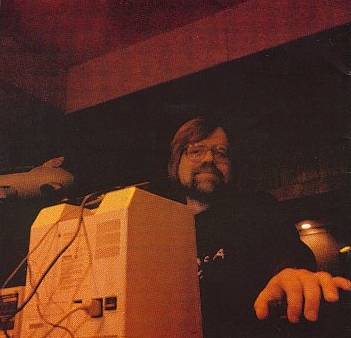 David Borden has been
active on the electronic music scene for more than three decades. In 1967, he first made
contact with Robert Moog and his synthesizers. After a couple of years
experimenting in the Moog Studio, changing his methods of composing and learning the outer
limits of what was possible on these new instruments, he founded the band Mother
Mallard (the first all-Moog ensemble), together with Steve Drews and
Linda Fisher. Mother Mallard became a pioneer band of Space Music, minimalism and
other innovative trends.
David Borden has been
active on the electronic music scene for more than three decades. In 1967, he first made
contact with Robert Moog and his synthesizers. After a couple of years
experimenting in the Moog Studio, changing his methods of composing and learning the outer
limits of what was possible on these new instruments, he founded the band Mother
Mallard (the first all-Moog ensemble), together with Steve Drews and
Linda Fisher. Mother Mallard became a pioneer band of Space Music, minimalism and
other innovative trends.
How did your musical vocation begin?
"Jorge, if you really want to know the answer to that question, I'll have to go back
to the Second World War. In September of 1944, during the first weeks of school (this was
First Grade), the teacher asked if anyone in the class was interested in taking piano
lessons through the school. Our Public School System in Brookline, Massachusetts was among
the top public school systems in the USA (the lessons were only $1 because the school
subsidized them). I immediately raised my hand and Miss Clifford took down my name. A few
days later I received news that I was too young to start lessons. I was 5 but the
guidelines stipulated that the student must be at least 6. That day when I walked home
from school, I started crying when I reached my street. My mother (unknown to me) always
looked out for me through the window (the third floor of a three family walk-up) and
rushed down to greet me, asking me what was wrong. The next day, my father went to the
school and convinced the principal that they should give me a chance and start me on a
trial basis. And of course, the rest is history, as they say. My father learned to play
the piano late in life (really starting at age 33) and so we had an upright piano in the
house when I was born. As I was coming into consciousness as an infant, I heard my father
practising whenever he came home. His job before the war was as a bouncer at a restaurant
and bar in a very rough section of Boston. He had been a champion gymnast in high school,
and was very muscular. There's a lot I could say about the circumstances, but suffice to
say, he practised Chopin, Lizst, Grieg, Gershwin, and various popular ragtime pieces of
the day like Nola, Dizzy Fingers, and Wabash Blues. I can still hear him pounding out
sections of Gershwin's Rhapsody in Blue over and over again for hours (maybe that's why I
took to repetition so easily?!) That, I think, was really my beginning as a musician, just
listening to him practise in the next room. We lived in a five room apartment with my
grandparents and had no central heating. My bedroom was next to the living room where the
piano was. I think that this close proximity to constant piano practising routines
subconsciously trained my ears so that I developed perfect pitch, because as soon as I
started taking piano lessons myself, learning the letter names of the notes, I instantly
recognized the pitches on the piano without looking at them. There's a lot more I could
say about this environment that was very positive to my development, but basically it was
this early beginning, and the always-present and constant parental support that were the
things that made my vocation possible."
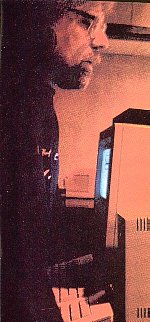 How did you discover the electronic
instruments for the first time and when did you realize that they were necessary to
develop your music?
How did you discover the electronic
instruments for the first time and when did you realize that they were necessary to
develop your music?
"My first encounter with electronic instruments, and electronic methods of composing
(with tapes and tape manipulation) were through recordings of Otto Luening and Vladimir
Ussachevsky in the late fifties. But it was the work of John Cage that I grew to love. It
was when I was studying with Boris Blacher at the Hochschule für Musik in Berlin in
1965-66 that I saw my first electronic studio. He was showing me how he had completed an
opera which included synthesized sounds. But it wasn't until 1967 in Ithaca NY, where I
was Composer-in-Residence in the School District due to a Ford Foundation Grant, that I
first made contact with Robert Moog and his synthesizers. Bob showed me his studio which
was located at his company site in Trumansburg NY, just a short distance from Ithaca. He
gave me access to the place and a basic introductory lecture on how all the stuff worked.
But since I am such a slow learner (and continue to be!), it wasn't until 1968 that I felt
I had full command over the Moog Synthesizer as a studio instrument. Remember, this was
before live performances on synthesizers, and it was just a studio recording medium at
that time. And also, even though these early synthesizers were controlled by keyboards,
they were monophonic; i. e. no more than one note at a time was recognized by the
instruments. After a couple of years experimenting in the Moog Studio, changing my methods
of composing, learning how to be a recording engineer on state-of-the-art four track tape
recorders and learning the outer limits of what was possible on these new instruments, I
was ready to try live performances using these studio-bound instruments. Richard
Teitelbaum had already been performing live on a Moog in Rome as part of Musica
Eletronnica Viva. But no one had ever tried using several Moogs in an ensemble, mainly
because they were so expensive. But with Moog's help Mother Mallard (my new music group)
and the First Moog Quartet began doing just that. The First Moog Quartet played
arrangements of pieces from the classical repetoire--and I'm not certain of the dates of
their existence, but it was short-lived. Mother Mallard started doing music especially
created for the Moogs in 1969. The first all-Moog Mother Mallard ensemble consisted of
composer/keyboardists Steve Drews, Linda Fisher and me."
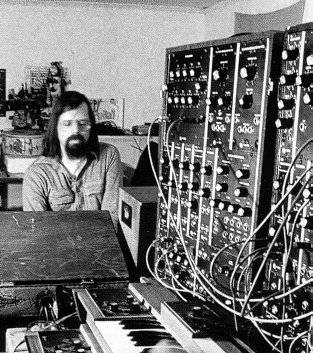 Which synthesizers, electronic
instruments and equipment do you use in your music? And in 1970-73?
Which synthesizers, electronic
instruments and equipment do you use in your music? And in 1970-73?
"I started accumulating post-Moog stuff in the mid-eighties. I now have a bunch of
rackmounted synths controlled by a Yamaha KX-88 for live performance and recording.
Included are the following: Oberheim Matrix 1000, Yamaha FB01s, TX81Z, TX802, TX816, E-Mu
Proteus-2, Alesis QuadraSynth + Piano, QS7, Korg X5DR, Wavestation, M1Rex, Roland Juno 60,
MiniMoog (MIDI), Digidesign SampleCell, and most recently, a Novation Supernova. Whew!
That's a lot of stuff. I also have a Unity DS-1 Sampler, but haven't used it yet. I'm
thinking of adding a really good E-Mu Sampler, and then I can own the world. At the
Cornell Studio, I have more stuff and also access to ProTools. I also have an S-Video
Player with a video capture card and monitor for film work. Add to that a Tascam D-88 and
a Panasonic stereo DAT recorder, a couple of effects boxes, and that rounds it out. And, I
almost forgot-running the whole thing is a Macintosh G3 with MOTU software and a couple of
MOTU MTP AV Midi Timpieces."
"In 1970-73 we used three modular Moog systems and two MiniMoogs plus an RMI Piano.
We had two Scully tape recorders, a four-track and a two-track, plus a Revox two-track. I
forget the kind of mixer we had, but it was very good for its day. Although this setup
sounds simpler, it was much more difficult to record due both to the limitation of
separate tracks and the lack of any synchronizing technology save for the ever-present
click tracks. One had to keep playing for an entire take, sometimes lasting twenty minutes
or more, with no mistakes."
Has Terry Riley or other musicians been a big influence for your musical career,
especially at the beginning??
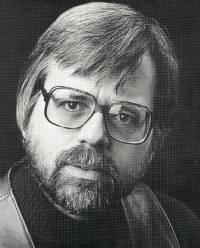 "I first heard the Columbia
recording of Terry's In C in 1968 and it jolted me into recognition: YES, this is the
direction I want to take. It was such an iconoclastic statement against the hegemony of
academic music of the time, that it had a great influence on other younger composers,
especially Steve Reich who had attended the first performance of the piece in 1964 at
Mills College. On the liner notes of the album, I noticed that an old friend of mine, Jon
Hassell, was playing trumpet. I knew he was in Buffalo as a Rockefeller Creative Fellow so
I called him. He told me that Terry was there also, and so I visited Buffalo and met Terry
Riley. We didn't talk about anything of importance, but he and his wife talked about Zap
Comix, so I acquired a complete collection."
"I first heard the Columbia
recording of Terry's In C in 1968 and it jolted me into recognition: YES, this is the
direction I want to take. It was such an iconoclastic statement against the hegemony of
academic music of the time, that it had a great influence on other younger composers,
especially Steve Reich who had attended the first performance of the piece in 1964 at
Mills College. On the liner notes of the album, I noticed that an old friend of mine, Jon
Hassell, was playing trumpet. I knew he was in Buffalo as a Rockefeller Creative Fellow so
I called him. He told me that Terry was there also, and so I visited Buffalo and met Terry
Riley. We didn't talk about anything of importance, but he and his wife talked about Zap
Comix, so I acquired a complete collection."
"Later, in the early days of Mother Mallard when we played in New York City at
various avant garde venues, we always made a point to get the equipment out of the city
after the performance for fear of theft. Helping us in this endeavor was composer David
Behrman who put us up at his rural house near Bear Mountain about an hour outside the
city. David had produced the In C recording, and was also associated with Merce Cunningham
and John Cage. David Behrman, along with Gordon Mumma, was the first composer I knew who
used a computer in live performance. David and Gordon both made their own. But getting
back to Terry, yes he had a positive influence at the same time that I was discovering
synthesizers. Eventually my music became less European influenced, and began using
repetitive figures, tonality and a steady pulse. These are all things I had used in my
jazz musician days, but which I hadn't used in my concert music. Terry and to some extent,
John Cage, influenced my thinking into including everything into one technique. My first
attempt at a holistic approach. Buckminster Fuller was also a very big influence with his
ideas on synergy."
How is the process you follow to compose / record a piece?
 "My musical ideas come from both
abstract musical material and extra-musical items such as a person's name. For instance
the anagram of your name is "He runs, men jog". I have a series of pieces called
Anagram Portraits, so I could do yours on a running theme. I also have composed a series
of variations on a theme of Philip Glass. One set within the variations is a mirror fugue
set- -entirely arrived at non-verbally with musical ideas only. But there is an
intellectual idea behind including a mirror fugue, after all mirrors are made of glass.
Almost all of my music is contrapuntal, that is, each line has its own important identity.
There's not much melody and accompaniment, although this occasionally happens."
"My musical ideas come from both
abstract musical material and extra-musical items such as a person's name. For instance
the anagram of your name is "He runs, men jog". I have a series of pieces called
Anagram Portraits, so I could do yours on a running theme. I also have composed a series
of variations on a theme of Philip Glass. One set within the variations is a mirror fugue
set- -entirely arrived at non-verbally with musical ideas only. But there is an
intellectual idea behind including a mirror fugue, after all mirrors are made of glass.
Almost all of my music is contrapuntal, that is, each line has its own important identity.
There's not much melody and accompaniment, although this occasionally happens."
"I usually begin by recording one line into Performer (the MOTU sequencer) and then
add various other lines to it. Sometimes I compose one person's part all the way through
before adding another part, something I have done since the early Moog Synthesizer days.
With sequencing, I can try out various permutations of any line or section by inverting
it, playing it backwards (retrograde) or changing the mode, all very quickly so that I can
hear what it sounds like almost instantly. That's what computer technology has given
us--more options to work with in a very short time. Before, working things out may have
taken much longer. Both ways of working have their good points and bad. When I'm not
satisfied with the result I will often go back and work "the old-fashioned way"
at a piano with a pencil."
"When recording, I usually make a recording as soon after completing a piece as I
can. This may not be the master for what is eventually released on a CD, but it is a
pretty good idea of what I want the piece to sound like."
Can you tell us about your activity in the Digital Music Program at the Cornell
University?
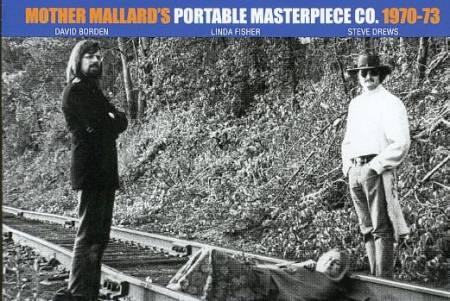 "I am the Director of the Digital
Music Program at Cornell, and have developed all of the courses connected with it. These
courses range from complete beginners at the undergraduate level to graduate student
composers who want to know how to design and work in a MIDI-based digital audio
environment. It's very difficult for composers to find positions in universities these
days without any knowledge of electronic media, especially computer software used for
composing, performing and publishing scores."
"I am the Director of the Digital
Music Program at Cornell, and have developed all of the courses connected with it. These
courses range from complete beginners at the undergraduate level to graduate student
composers who want to know how to design and work in a MIDI-based digital audio
environment. It's very difficult for composers to find positions in universities these
days without any knowledge of electronic media, especially computer software used for
composing, performing and publishing scores."
What's your opinion about the evolution of the world electronic music scene during
1970-1999? What do you think the musical scene will be in the next 30 years?
"When I first started in electronic music in 1967, Robert Moog couldn't convince one
music store in the USA to carry his synthesizers. Now, of course, every music store has
several synthesizer systems to choose from, and not only that, digital pianos have
replaced acoustic pianos as an entry level keyboard for many piano students and homes.
That is something no one foresaw thirty years ago. What is disappointing is that most
"classical" composers view the synthesizer as some kind of "add- on"
in special situations instead of a "serious" instrument. Whereas pop music is
permeated with all types of electronic keyboard instruments. I'm hoping that the day soon
comes when electronic keyboards are more than novelty items in the classical arena. I
realize that many serious composers work in the electronic medium, it's just that it is
still not integrated into the mainstream classical paradigm."
If you wish to purchase any recordings by David Borden you only have to
use this link.
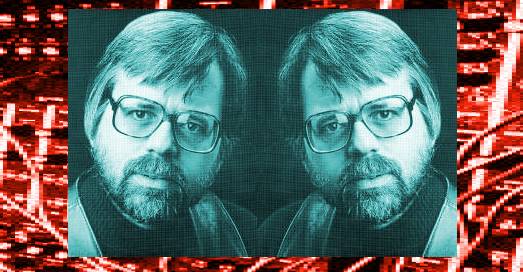
 Previous Page (Articles/News)
Previous Page (Articles/News)
 David Borden has been
active on the electronic music scene for more than three decades. In 1967, he first made
contact with Robert Moog and his synthesizers. After a couple of years
experimenting in the Moog Studio, changing his methods of composing and learning the outer
limits of what was possible on these new instruments, he founded the band Mother
Mallard (the first all-Moog ensemble), together with Steve Drews and
Linda Fisher. Mother Mallard became a pioneer band of Space Music, minimalism and
other innovative trends.
David Borden has been
active on the electronic music scene for more than three decades. In 1967, he first made
contact with Robert Moog and his synthesizers. After a couple of years
experimenting in the Moog Studio, changing his methods of composing and learning the outer
limits of what was possible on these new instruments, he founded the band Mother
Mallard (the first all-Moog ensemble), together with Steve Drews and
Linda Fisher. Mother Mallard became a pioneer band of Space Music, minimalism and
other innovative trends. How did you discover the electronic
instruments for the first time and when did you realize that they were necessary to
develop your music?
How did you discover the electronic
instruments for the first time and when did you realize that they were necessary to
develop your music? Which synthesizers, electronic
instruments and equipment do you use in your music? And in 1970-73?
Which synthesizers, electronic
instruments and equipment do you use in your music? And in 1970-73? "I first heard the Columbia
recording of Terry's In C in 1968 and it jolted me into recognition: YES, this is the
direction I want to take. It was such an iconoclastic statement against the hegemony of
academic music of the time, that it had a great influence on other younger composers,
especially Steve Reich who had attended the first performance of the piece in 1964 at
Mills College. On the liner notes of the album, I noticed that an old friend of mine, Jon
Hassell, was playing trumpet. I knew he was in Buffalo as a Rockefeller Creative Fellow so
I called him. He told me that Terry was there also, and so I visited Buffalo and met Terry
Riley. We didn't talk about anything of importance, but he and his wife talked about Zap
Comix, so I acquired a complete collection."
"I first heard the Columbia
recording of Terry's In C in 1968 and it jolted me into recognition: YES, this is the
direction I want to take. It was such an iconoclastic statement against the hegemony of
academic music of the time, that it had a great influence on other younger composers,
especially Steve Reich who had attended the first performance of the piece in 1964 at
Mills College. On the liner notes of the album, I noticed that an old friend of mine, Jon
Hassell, was playing trumpet. I knew he was in Buffalo as a Rockefeller Creative Fellow so
I called him. He told me that Terry was there also, and so I visited Buffalo and met Terry
Riley. We didn't talk about anything of importance, but he and his wife talked about Zap
Comix, so I acquired a complete collection." "My musical ideas come from both
abstract musical material and extra-musical items such as a person's name. For instance
the anagram of your name is "He runs, men jog". I have a series of pieces called
Anagram Portraits, so I could do yours on a running theme. I also have composed a series
of variations on a theme of Philip Glass. One set within the variations is a mirror fugue
set- -entirely arrived at non-verbally with musical ideas only. But there is an
intellectual idea behind including a mirror fugue, after all mirrors are made of glass.
Almost all of my music is contrapuntal, that is, each line has its own important identity.
There's not much melody and accompaniment, although this occasionally happens."
"My musical ideas come from both
abstract musical material and extra-musical items such as a person's name. For instance
the anagram of your name is "He runs, men jog". I have a series of pieces called
Anagram Portraits, so I could do yours on a running theme. I also have composed a series
of variations on a theme of Philip Glass. One set within the variations is a mirror fugue
set- -entirely arrived at non-verbally with musical ideas only. But there is an
intellectual idea behind including a mirror fugue, after all mirrors are made of glass.
Almost all of my music is contrapuntal, that is, each line has its own important identity.
There's not much melody and accompaniment, although this occasionally happens." "I am the Director of the Digital
Music Program at Cornell, and have developed all of the courses connected with it. These
courses range from complete beginners at the undergraduate level to graduate student
composers who want to know how to design and work in a MIDI-based digital audio
environment. It's very difficult for composers to find positions in universities these
days without any knowledge of electronic media, especially computer software used for
composing, performing and publishing scores."
"I am the Director of the Digital
Music Program at Cornell, and have developed all of the courses connected with it. These
courses range from complete beginners at the undergraduate level to graduate student
composers who want to know how to design and work in a MIDI-based digital audio
environment. It's very difficult for composers to find positions in universities these
days without any knowledge of electronic media, especially computer software used for
composing, performing and publishing scores."